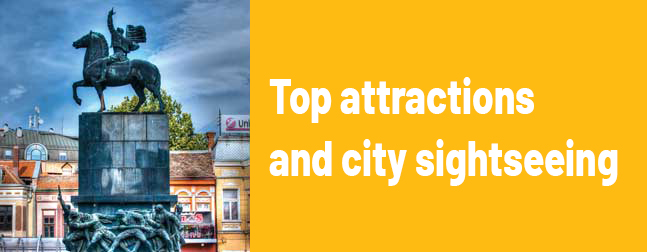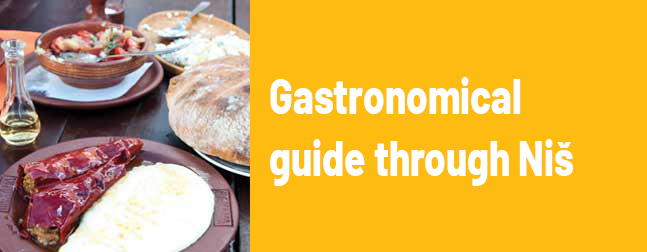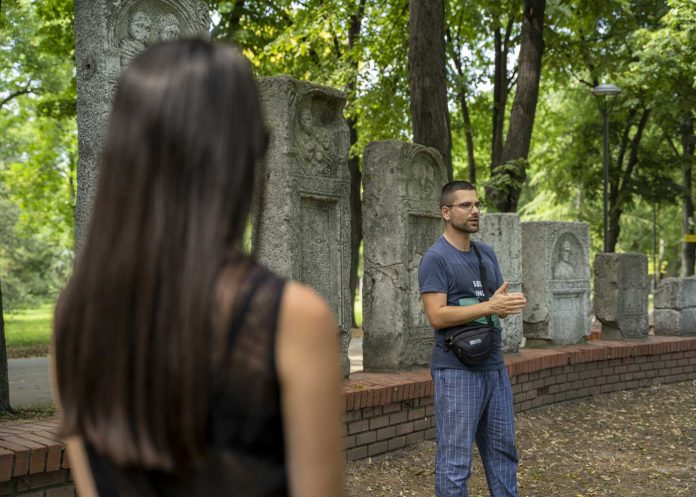Walking tour 1: Historical walk through the city center
Duration: 3 hours
Walking tour 1: Historical walk through the city center
Duration: 3 hours
For easier navigation, we recommend that you visit one of the Tourist Info Centers – Tourist Organization of Niš, where you can get a map and a brochure about the localities that you will visit. If you want to hire a local tour guide, you can find contacts at this link.
We suggest that you do not miss the following interesting points during your walking tour through the center of Niš:
- Orthodox Cathedral
You can start your walking tour with one of the most beautiful sacral buildings in Serbia – Orthodox Cathedral, which was built just before the liberation of Niš from the Ottoman rule, in December 1877. Next to it is the church of St. Archangels Michael and Gabriel – Small Cathedral, built in 1819.
2. Monument to Stevan Sremac and Kalča
The monument is dedicated to the Serbian writer of realistic novels from the end of the 20th century, Stevan Sremac and the hunter Kalča – a character from his novel “Ivkova slava”. Stevan Sremac was one of many who was enchanted by the speech of residents of Niš, so he wrote his works in the southern dialect and so vividly evoked the virtues and passions of people from the south.
3. Tinkers Alley
Tinkers Alley is the last preserved street of the former town of Niš. At the beginning of the 19th century, it was a craftsman’s alley, with a large number of potters’ workshops, hence its name. The buildings in Tinkers Alley have been renovated over time and arranged as restaurants, cafes, taverns and hotels that have retained the spirit of old architecture.
4. Archeology Hall of the National Museum
In the Archaeological Hall, you will have the opportunity to get to know the civilizational development of Serbia and Europe from prehistory to the Middle Ages. Here, among other things, a valuable treasure of ancient Naissus awaits you, such as sculptures of Roman deities, coins, mosaic pieces, temple fences, as well as a portrait of the most famous Roman born in Niš – Constantine the Great.
5. Stambolija House
Across from the Archaeological Hall there is another example of oriental architecture from the period of the rule of the Ottoman Empire – Stambolija House It was built in 1875 as a rich town house with more than ten rooms and belongs to the profane Balkan architecture.
6. A walk along Obrenovićeva Street, the main pedestrian zone, will take you to the main city square – King Milan Square. The central part of King Milan Square, the central square in Niš, occupies with its beauty and size – The Monument to the Liberators of Niš (1937). This monument is considered one of the most significant works of Yugoslav sculpture, and its author is Antun Augustinčić, a famous Croatian and Yugoslav sculptor. The monument was erected as a symbol of the liberation wars that were fought in Niš during the rule of the Ottoman Empire and during the First World War.
7. Čair fountain
One of the most beautiful and best-preserved fountains in Niš was erected in 1903. It was the only architectural monument in the central part of the city in the period before the First World War.
8. Mayor’s Office Building
The mayor’s office building is one of the most architecturally valuable buildings in Niš. It was built in 1925 in the spirit of neoclassicism with decorative ornaments and a characteristic entrance part.
9. Memorial to Constantine the Great
The memorial to the most important Roman emperor born in Niš was symbolically erected at the beginning of the bridge on the Nišava that leads to the Fortress, where Constantine spent most of his childhood. The monument depicts the figure of Emperor Constantine and Christ’s monogram.
10. If you continue your walk to the right, along the bank of the Nišava, above the amphitheater you can see a monument to Šaban Bajramović, one of the most influential Roma composers and performers of original music, who was born in Niš.
11. Officers Club
Near the monument to Šaban Bajramović, there is another historically significant building – Officers Club, which was the seat of the parliamentary and political life of Serbia at the beginning of the First World War. Of the numerous decisions voted, the most important is the Niš Declaration (December 7, 1914), by which Serbia made the decision to unite Serbs, Croats and Slovenes into one country – the Kingdom of Yugoslavia.
12. Before you enter The Fortress, one of the most important historical sites in the city center, on your left you will see The building of Banovina, which is considered one of the most beautiful buildings in Niš. Its historical significance is related to July 28, 1914, when the Prime Minister of the Kingdom of Serbia, Nikola Pasić, was handed a telegram in this building by which Austro-Hungary declared war on Serbia. On that day, the biggest conflict in the history of the world – the First World War – began in Niš.
13. The Fortress
Niš Fortress is one of the most beautiful and best preserved medieval fortresses in the Central Balkans. It visually dominates the city center and occupies an area of 22 hectares. The mighty, stone ramparts are 2100 meters long, 8 meters high and 3 meters wide. It was built by the Romans, Byzantines and Serbs, demolished and rebuilt several times, to be given its final appearance by the Ottomans in 1730. Apart from the well-preserved massive stone walls and gates, numerous remains of the turbulent history of Niš can be seen in The Fortress.







